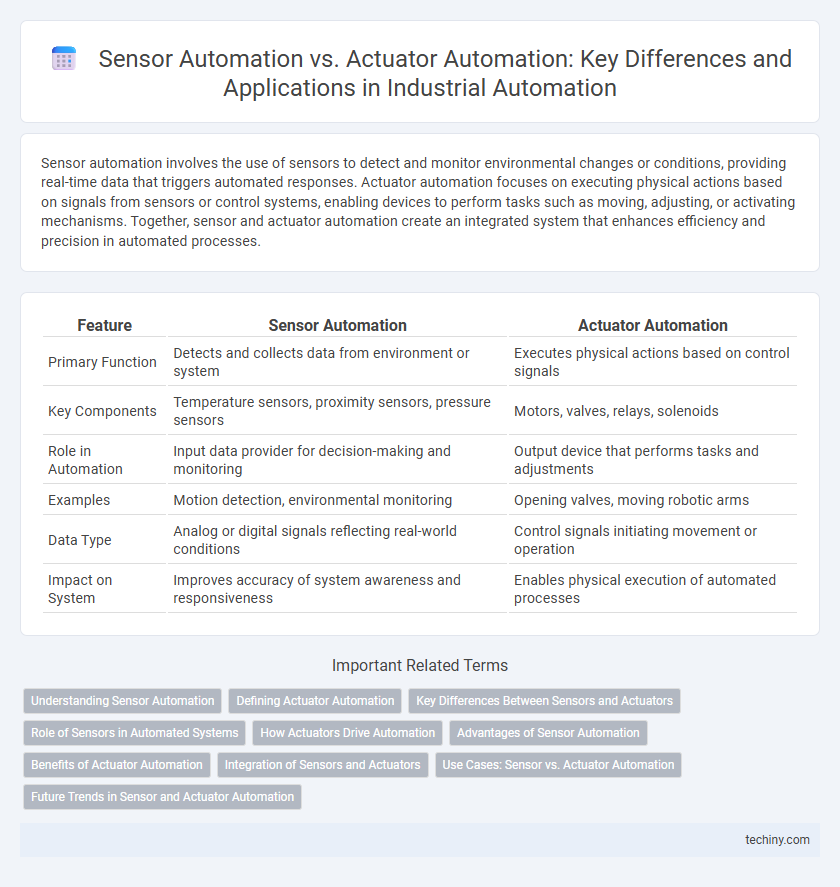Sensor automation involves the use of sensors to detect and monitor environmental changes or conditions, providing real-time data that triggers automated responses. Actuator automation focuses on executing physical actions based on signals from sensors or control systems, enabling devices to perform tasks such as moving, adjusting, or activating mechanisms. Together, sensor and actuator automation create an integrated system that enhances efficiency and precision in automated processes.
Table of Comparison
| Feature | Sensor Automation | Actuator Automation |
|---|---|---|
| Primary Function | Detects and collects data from environment or system | Executes physical actions based on control signals |
| Key Components | Temperature sensors, proximity sensors, pressure sensors | Motors, valves, relays, solenoids |
| Role in Automation | Input data provider for decision-making and monitoring | Output device that performs tasks and adjustments |
| Examples | Motion detection, environmental monitoring | Opening valves, moving robotic arms |
| Data Type | Analog or digital signals reflecting real-world conditions | Control signals initiating movement or operation |
| Impact on System | Improves accuracy of system awareness and responsiveness | Enables physical execution of automated processes |
Understanding Sensor Automation
Sensor Automation involves the integration of sensors to continuously monitor physical conditions such as temperature, pressure, or humidity, enabling real-time data collection for precise system control. This technology enhances process efficiency by providing accurate feedback that drives automated adjustments without human intervention. Advanced sensor automation systems utilize IoT connectivity and machine learning algorithms to predict maintenance needs and optimize operational performance.
Defining Actuator Automation
Actuator automation involves the use of devices that physically manipulate or control a system based on input signals, translating automated commands into mechanical motion or changes in the environment. Unlike sensor automation, which focuses on data acquisition and environment monitoring, actuator automation directly impacts system operation by driving movements such as opening valves, adjusting motors, or positioning robotic arms. Effective actuator automation integrates with control systems to ensure precise and timely responses, enhancing efficiency and accuracy in industrial processes.
Key Differences Between Sensors and Actuators
Sensors detect and measure physical parameters such as temperature, pressure, or motion, providing real-time data input for automation systems. Actuators convert control signals into physical actions, enabling mechanical movement or adjustment in automated processes. The key difference lies in sensors being input devices that gather data, while actuators are output devices that execute commands.
Role of Sensors in Automated Systems
Sensors in automated systems play a critical role by continuously monitoring environmental conditions and providing real-time data for decision-making processes. They detect physical parameters such as temperature, pressure, or motion, enabling the system to respond accurately and maintain optimal performance. This data-driven feedback is essential for actuator automation to execute precise mechanical actions, ensuring efficiency and safety in industrial automation.
How Actuators Drive Automation
Actuators play a crucial role in driving automation by converting electrical signals into physical movement, enabling machines and systems to perform precise and repeatable tasks. Unlike sensors that detect and collect data, actuators execute commands by controlling valves, motors, and other mechanical components, directly influencing operational processes. Efficient actuator automation enhances productivity, reduces human intervention, and ensures seamless integration within automated workflows across manufacturing and industrial environments.
Advantages of Sensor Automation
Sensor automation enhances process efficiency by providing real-time data that enables precise monitoring and rapid system adjustments. It reduces human error and maintenance costs by detecting anomalies early, ensuring higher reliability and safety in automated systems. Integrating sensor automation supports predictive analytics, optimizing operational performance and prolonging equipment lifespan.
Benefits of Actuator Automation
Actuator automation enhances system efficiency by directly controlling mechanical movements, resulting in faster response times and increased precision in industrial processes. It reduces human intervention, minimizing errors and lowering operational costs through improved reliability and consistency. Integration with sensor automation enables seamless feedback loops, optimizing real-time adjustments and overall productivity.
Integration of Sensors and Actuators
Integration of sensors and actuators in automation systems enables real-time data acquisition and precise control actions, enhancing operational efficiency. Sensors detect environmental or process variables, transmitting critical data to controllers which then activate actuators to execute mechanical movements or adjustments. This seamless coordination between sensor input and actuator output is fundamental to advanced automation, facilitating adaptive responses and optimizing system performance.
Use Cases: Sensor vs. Actuator Automation
Sensor automation excels in real-time data collection and environmental monitoring, enabling predictive maintenance, quality control, and safety compliance in industries like manufacturing and agriculture. Actuator automation drives physical processes by controlling machinery, robotics, and equipment in automotive production lines, packaging, and HVAC systems. Combining sensor data with actuators enhances process efficiency through responsive adjustments and precise control in smart factories and automated warehouses.
Future Trends in Sensor and Actuator Automation
Future trends in sensor automation emphasize increased integration of AI-driven data analytics and edge computing to enhance real-time decision-making and predictive maintenance. Actuator automation is evolving with advances in smart materials and IoT-enabled control systems, enabling more precise and adaptive physical responses in industrial environments. The convergence of sensor and actuator technologies within Cyber-Physical Systems (CPS) will drive autonomous operations and improved efficiency across manufacturing and smart infrastructure sectors.
Sensor Automation vs Actuator Automation Infographic

 techiny.com
techiny.com